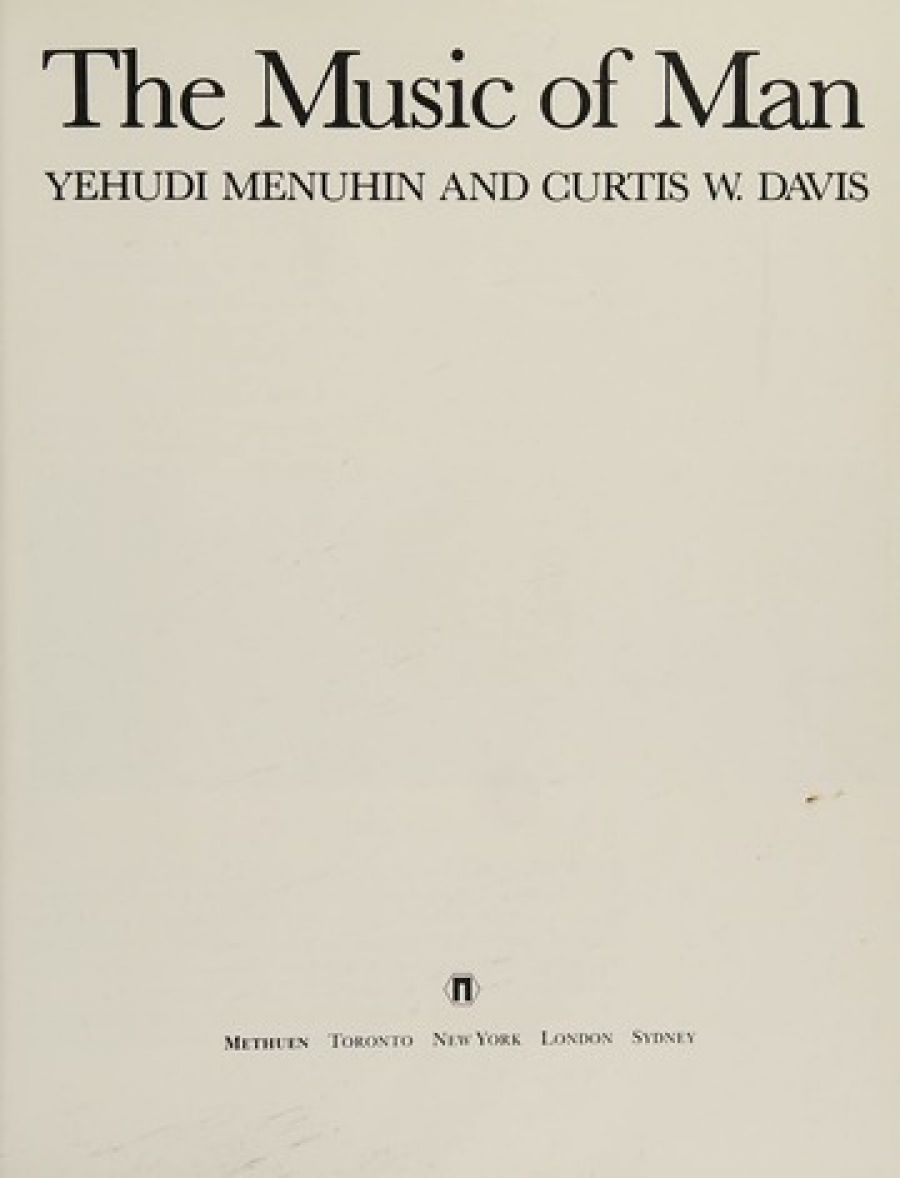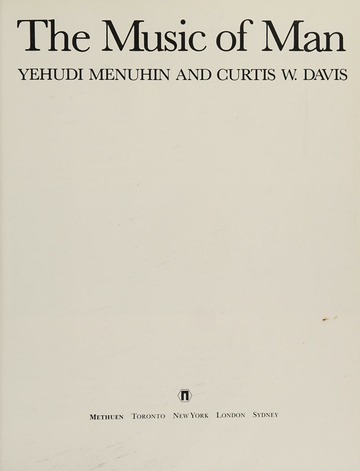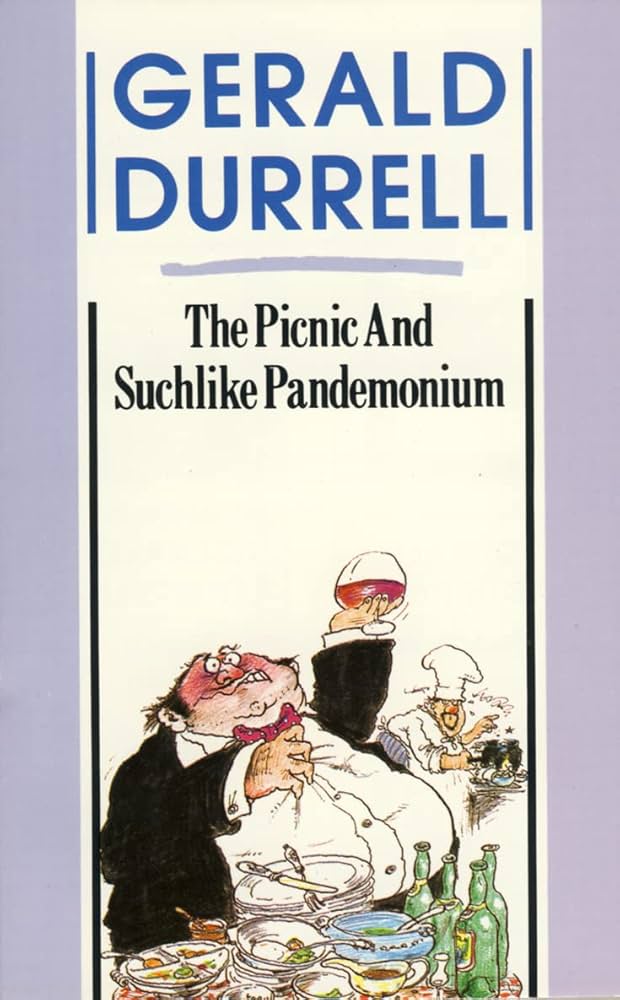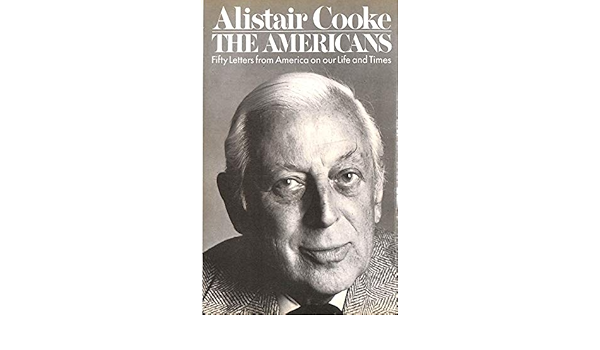
- Free Article: No
- Contents Category: Non-fiction
- Review Article: Yes
- Article Title: Menuhin, Durrell and Cooke
- Article Subtitle: Menuhin, Durrell, and Cooke
- Online Only: No
- Custom Highlight Text:
Irrespective of their countries of origin, books by remarkable men must command attention in the expectation that they will add to or consolidate knowledge, provide grounds for thought or useful debate or, hopefully, entertain.
- Book 1 Title: The Music of Man
- Book 1 Biblio: Methuen $24.95, 320 pp
- Book 1 Cover Small (400 x 600):

- Book 1 Cover (800 x 1200):

- Book 2 Title: The Picnic and Suchlike Pandemonium
- Book 2 Biblio: Collins $14.95, 193 pp
- Book 2 Cover Small (400 x 600):

- Book 2 Cover (800 x 1200):

- Book 3 Title: ‘The Americans: Fifty Letters from America on Our Life and Times’
- Book 3 Biblio: Bodley Head, $16.95, 323 pp
- Book 3 Cover Small (400 x 600):

- Book 3 Cover (800 x 1200):

In their own essentially different ways Yehudi Menuhin, Gerald Durrell, and Alistair Cooke live up to one or more of these expectations.
Few people will deny that Menuhin is the most remarkable of these three.
Born in the US of Russian-Jewish parentage in 1916, he was hailed as a prodigy at the age of twelve, and subsequently recognised as a modern maestro and, possibly, a genius. In recent years he has been honored as a practicing humanitarian.
From The Music of Man, based on an eight-part Canadian television series, Menuhin emerges as a self-confessed paradox – ‘a moderate fanatic’ in applying his philosophy that music forms a universal bond linking all mankind.
His concepts are all-embracing:
Music may happen to be expressive, communicative, moving and inspired, but it is rarely accidental, even when it is recalling the everlasting sound of the sea or the spontaneity of birdsong. The cry of the newborn child is as much the intrinsic sound of music as is the staccato hammering of the woodpecker, the crash of thunder, the rustle of the wind through the wheat field, the cooing of the dove, the rattle of seed pods, the clank of metal, the soft tread of feet on the underbrush.
Is it not in these very natural sounds that is largely found the raw material for the creation of man’s music?
In developing this theme in The Music of Man, Menuhin traces the origins of music from ‘the Quiver of Life’ in prehistoric times to the mass frenzy producing sounds of today’s ‘glitter’ rock.
Vast in scope though this may appear or be interpreted, the book is not an encyclopedia. To regard it so is contrary to Menuhin’s stated purpose:
I hope this book will provide the equivalent topographical maps showing the position music throughout the ages, alternating general overall views which reveal long-term trends, cultural interactions and the ways of life with close-ups of particular situations and periods. These maps, of course, can only be taken as samples, but I should like to think that The Music Of Man will provide a compass, a guide, to our aural environment. With this crude compass, you might be able to polarise the relative positions of various styles and types of music in the scheme of things, to find out where, perforce, much to be omitted, and to discover for yourself where it might properly belong.
The latter suggestion is acceptable because, at the end of the book, there is a bibliography that appears to be worthwhile but I take issue on the use of the word ‘crude’.
The Music of Man does not lack polish or finish. Printed and bound in Canada, it is presented as a publication that the publisher obviously considers to be prestigious … and rightly so.
It is highlighted by illustrations that together create visual pleasure. They range from a colored photograph of a prehistoric musical ensemble consisting of the shoulder blades and hip bones of a mastodon uncovered in the Siberian ice. Through ancient prints, woodcuts, and paintings to scenes at Woodstock and a photograph of one of the great warning voices of our time … Bob Dylan.
Understandably and appropriately, most of The Music of Man can be described as tranquil but there is jolting discord when Menuhin surveys contemporary rock and roll.
He identifies it as ‘the music of disillusion, of a generation set adrift from the past’ and tells of his meeting with the Rolling Stones. As you read it, bear in mind that the maestro of the violin is no mean exponent of jazz:
In 1976 I received word that one hundred tickets to the Stones opening performance at Earl’s Court were at my disposal to be sold as a benefit for my school. I felt this would be the right time to see what the Stones were like, and I did want to thank them for their gesture. We arrived at Earl’s Court behind schedule when the warm-up groups were finishing. I had already been told a great deal about the atmosphere surrounding the Stones, what kind of people they were. We arrived in great style in the huge black car which had been provided for us, driving right into the garage behind Earl’s Court where we joined other cars of like extravagance. Though we were some distance from the hall, I heard what sounded to me like a premonition of hell.
We edged up the narrow stairs into the while the sound grew like a thunderstorm. I wanted to listen for the musical content, but for me the sheer volume obliterated the possibility.
For the first time I experienced real physical pain hearing music. Of notes, pitches, musical design, I could distinguish little. It seemed to me quite unlike the music of the Beatles which has a real melodic quality, whereas this was aural overkill: a sheer sound wall. Under such circumstances, I understood how deliberately the whole madness is engineered. It aims to numb all aware senses, to leave no choice but to surrender and participate. I did neither I – left after ten minutes.
But Menuhin is not pessimistic. He leaves us in the hope that our young people will rediscover the music of the past.
Dedicated to the preservation of the world’s wildlife, in which he is often encouraged by Menuhin’s friendship, Gerald Durrell has a vast zest for life. He has a Rabelaisian sense of humor, a rich love of women, exotic foods, wines, and books, and has an entertaining way with words. Each characteristic is reflected in The Picnic and Suchlike Pandemonium, a collection of six short stories-cum-vignettes probably based on fragments of fact and converted into rollicking fiction or, as in the case of two pieces, ventures into the occult and bizarre.
In The Picnic he continues to lampoon his long-suffering family and to depict his brother Lawrence, the novelist, as irascible. In a noteworthy passage, Gerald focuses on his brother-in-law’s nose – an organ apt to take on a rubicund sheen at the smell of kippers:
He was a man of medium height with a mop of curly dark hair, prominent bright blue eyes, and a nose any Roman emperor would have been glad to possess. It was a nose that really WAS a nose; a nose to be reckoned with; a nose of size and substance, one that would have warmed the cockles of Cyrano de Bergerac’s heart, a nose that heralded the cold weather, the opening of the pubs, mirth, or any other important event, with a flamboyant color change that a chameleon would have envied. It was a nose to be arrogant with, or shelter behind in moments of stress. It was a nose which could be proud or comic, according to the mood; a nose that once seen was never forgotten, like the beak of a duck billed platypus.
‘The Maiden Voyage’, the second story in Durrell’s collection, is the improbable but hilarious saga of a cruise on a Greek ship aboard which Margo – Durrell’s sister – is locked in a toilet with the ship’s lugubrious engineer. If you are acquainted with that ribald ditty ‘Three Old Ladies Locked In A Lavatory’ you will have some idea of the story’s theme.
‘In The Havoc of Havelock’, Durrell unleashes sexual mayhem by lending the staff of a sedate hotel various volumes of The Psychology of Sex, the earnest, pedantic, humorless study by Havelock Ellis published between 1897 and 1928.
Durell’s description of the bookshop from which he purchased the tomes is a delight and surely deserves a place in ABR:
Here, in a tall, narrow house, is housed a vast and fascinating collection of new and second-hand books. On the ground floor and in the basement all the new books glare at you somewhat balefully in their multi-colored dust-jackets, but climb the creaking, uneven staircase to the four floors above, and you are transported into a Dickensian landscape. Here, from floor to ceiling in every room are amassed arrays of old books.
They line the walls of the narrow staircases, they surround you, envelop you, a wonderful, warm scented womb.
Pluck the books out and each smells different. One smells not only of dust but of mushrooms; another, autumn woods or broom flowers in the hot sun, or roasting chestnuts; and some have the acrid, damp smell of coal burning; and others smell of honey. And then, as if the smells alone are not enough, there is the feel of them in the heavy leather bindings, sleek as a seal, with the golden glitter of the type buried like a vein in the glossy spine.
Books the dimensions of a tree trunk, books as slender as a wand, books printed on paper as thick and as soft as a foxglove leaf, paper as white and crisp as ice, or as delicate and brittle as the frost layer on a spider’s web. Then the colors of the bindings: sunsets and sunrises, autumn woods aflame, winter hills of heather; the multicolored, marbled endpapers like some Martian cloud formation. And all this sensuous pleasure to drug and delight you before you have even examined the titles.
In the doubtful hall of fame represented by The Guinness Book of Records, the British Broadcasting Corporation’s Letter from America, featuring Alistair Cooke, is the longest running one-man series in broadcasting history.
Launched in March 1946 for a trial period of thirteen weeks, in its once-a-week format for UK listeners it is now heard throughout Europe, India, Africa, the Caribbean, Central America, Asia, and, of course, Australia.
It is not rebroadcast in North America because, Cooke says: ‘It would split the audience: ‘I am talking about America and not to America.’
This does not make sense because the Americans, to whom Cooke has best-selling status, will flock to their bookshops for copies of The Americans: Fifty Letters from America on Our Life and Times (Bodley Head, $16.95, 323 pp) which is based on his BBC series.
In the past they have had Letters from America, first published in l952, and Talk About America, published in l968.
The latest volume is written in Cooke’s normal urbane, non-controversial, occasionally tongue-in-cheek style. In this manner he ‘runs up and down the human scale that unites a Lancashireman to a Texan and a German to a Siamese’. It opens with his letter of 2 March 1969, and closes with that of his broadcast on 6 May 1979. In between he talks or, for the purposes of his book, writes on such topics as diet maniacs, jogging, Vietnam, Duke Ellington, acupuncture, Dean Acheson, Groucho Marx, and this, that, and the other. In many ways anecdotal, the end result is entertaining reading.


Comments powered by CComment